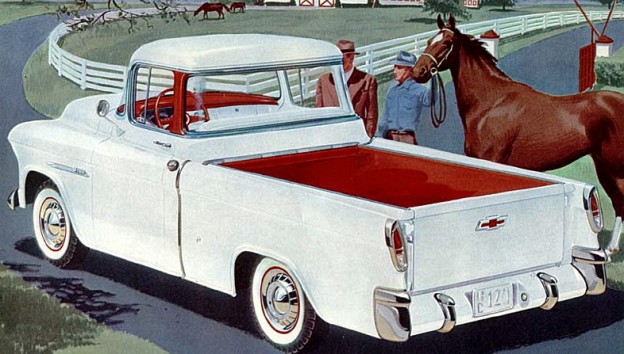Back in the mid 1950’s, the Chevrolet Cameo pickup was the first of the high-end luxury trucks with real pizzazz. Thanks to the knowledge General Motors obtained from the plastic-fantastic Corvette, the Cameo’s outer bed panels were made of lightweight fiberglass. At the time the Cameo came equipped with a high-end interior, the best of V8 power, automatic transmission and two-tone paint. In the 1950’s this made the Cameo a very avant-garde vehicle, and thus not many were built. Even more obscure is the GMC version – the Suburban Carrier.
Today, the Cameo is very rare. Today, I had the privilege to work on one (again!) – oh lucky me!! 
In a none-too-distant-future this Cameo will be a stablemate to my friend Barry’s Bel Air (click here to see it). What makes this Bel Air so damn special is that it has been in Barry’s family since new. Just imagine still owning the car you grew up since you were a kid!!
This Chevrolet Cameo has been at my cousin Jim’s shop numerous times on its way to being brought back to life. Jim has modified the frame, installed the new LS 5.3 liter engine (oh hell yeah!!) and done a huge amount of other fabrication work. I have written about it before; you can read more about it by clicking here and here.
Today we did some bodywork on the fiberglass outer bed panels.
To get the bed panels nice and straight, my cousin Jim previously sprayed them with sanding primer (the gray stuff) and today we worked some body-filler in order to ensure a very straight finish. Body filler is applied to the “low spots” on the panels. The great majority of this will eventually be sanded down. This takes patience and a steady hand. Yes it is tedious, it is messy (you get a ton of powder all over the place) and it takes time. And time. And more time. And yes, you guessed it, more time.
I’ve had quite a bit of stress and aggravation in the last few weeks, so working on Barry’s truck today was very therapeutic. This is the kind of stuff that “builds character”. It gives you time to think and well… I just enjoy doing this!
Sanding was done using an orbital air-powered sander, several sanding blocks of different shapes and sizes and different grades of sand-paper. Of course this is July 4th weekend and it was nice and warm (no – it was HOT!). Fortunately we had a few box-fans running and this made it tolerable.
Some folks say this is boring and a pain in the ass. Nope. This brought back fond memories of the endless hours I spent the summer I did this very same work on bowtie6 (click here). What made the Cameo different was that the sanding had to be more careful because I did not want to dig into the fiberglass gel-coat. After several hours we had this:
What is left now is just a film of filler covering the “low” spots on the body panel. If you look closely you can see some of the sanding blocks (on the top of the bed and on the floor). We had air-powered versions too but this has to be done the old-fashioned way: by hand.
Here is the cab on Barry’s cameo (yes, the photo is not perfect, I used my iPhone!):
So what’s next?
Well… We have some more sanding to do. There were a few spots that needed some more filling and further sanding to get really, really smooth. Then another coat or two of sanding primer followed by more sanding with even finer sandpaper. The idea is to get the surface straight and smooth.
Man! This was fun today. If you have never done this kind of work before, you are missing out on one of the pure joys of auto-restoration. I highly recommend it!
How is it done?
Filler is mixed from a paste in a can. Usually you would get about a golf-ball sized amount and add a pea sized amount of catalyst. This is then mixed very quickly on a special pad lined with paper until thoroughly blended. Then the fun begins. You must spread this with a special pad thin enough and quick enough while it is still malleable. After just a few minutes there is a point-of-no-return when the stuff gets too hard and grainy. On a hot day like today, the set time is even shorter.
Then, the filler is allowed to fully harden. Once it is hard to the touch, one can start sanding. The end result is a very fine powder that goes everywhere. Yes, it has a special odour and when I say it goes everywhere I really mean it. However, there is nothing like the feeling of accomplishment when you take an air-hose and then gently rub your hand on the body panel. If you have done it right, it will be as smooth as a newborn’s arse.
I’ll have more updates soon…





